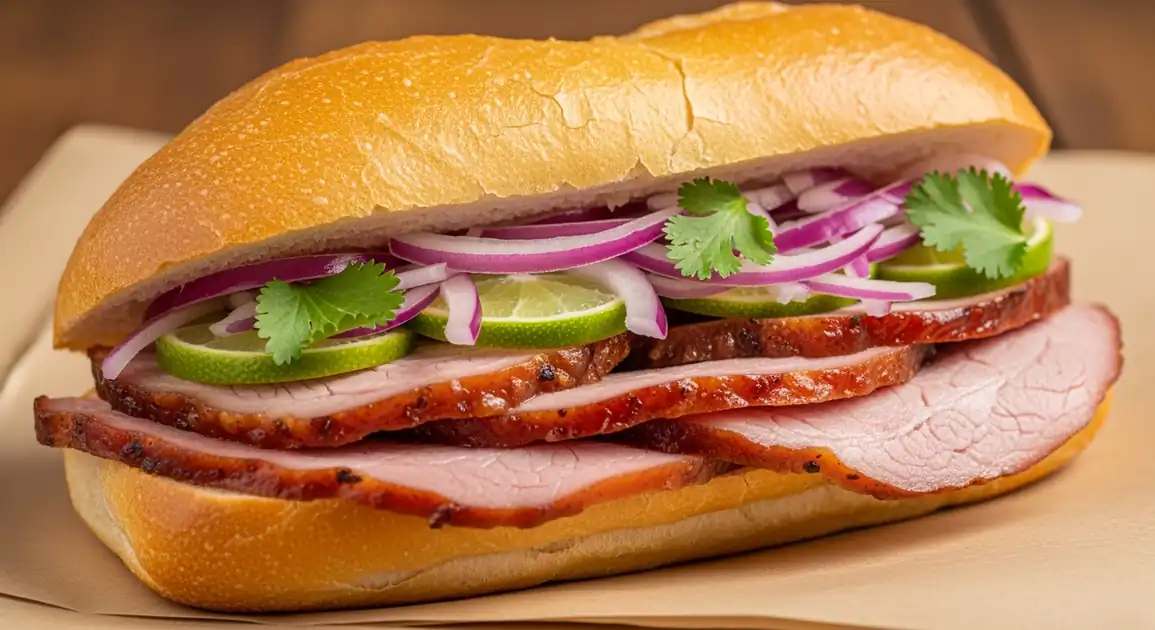Butifarra Sandwich
Sánguche de Butifarra

Description
Lima is the undisputed heart of butifarra culture in Peru, with countless sangucherías ranging from humble neighborhood spots to gourmet establishments. The capital city's version sets the standard nationwide, featuring the perfect balance of thinly sliced jamón del país and zesty salsa criolla on crusty pan francés. Several historic establishments have been serving traditional butifarra for generations, making it an essential Lima culinary experience.
Dietary Information
Serving information
Serving style
Served wrapped in paper, sometimes with a small plate underneath. Typically accompanied by napkins and sometimes extra lime wedges. Traditional accompaniments include chicha morada, Inca Kola, or beer.
Quick facts
Traditional sangucherías: 7 AM - 9 PM. Upscale spots in Miraflores/Barranco: 8 AM - 11 PM or later. Some places like La Lucha operate until 2 AM or later. Market stalls typically 7 AM - 5 PM.
Safety Tips
What to Look For
-
Ham sliced to order, not pre-sliced sitting out
Freshly sliced meat minimizes exposure to air and potential contamination. Pre-sliced ham sitting at room temperature is a significant risk factor.
-
Visible refrigeration for the ham
Proper cold storage of pork products is essential to prevent bacterial growth. Look for vendors with clear refrigeration systems.
-
Freshly prepared salsa criolla
The onion mixture should look bright and freshly made, not wilted or browned. Fresh criolla indicates attention to quality and food safety.
-
Clean preparation surfaces and utensils
Observe if the vendor maintains separate cutting boards for meat and vegetables, and regularly cleans surfaces.
-
High customer turnover
Popular spots with lines usually have fresher ingredients that don't sit around for long periods.
What to avoid
-
Pre-made sandwiches sitting in displays
Butifarra should be made to order. Pre-assembled sandwiches allow bacteria to multiply, especially if not properly refrigerated.
-
Meat that appears dry, discolored, or has a strong smell
These are signs the ham may be old or improperly stored. Quality jamón del país should be moist and have a fresh appearance.
-
Vendors handling money and food without washing hands or changing gloves
Poor hygiene practices increase cross-contamination risks. Look for vendors who have someone handling money separately or who wash hands/change gloves between tasks.
-
Unrefrigerated meat in warm weather
Especially concerning during Lima's summer months (December-March). Pork products should be kept cool until serving.
-
Salsa criolla that appears wilted or brownish
This indicates it was prepared long ago. The onions should be crisp and white/purple in color with green cilantro.
Price information
Price range
Budget tips
- Neighborhood sangucherías outside tourist zones offer authentic butifarra for 5-8 PEN.
- Famous historic spots like El Chinito charge 8-15 PEN for traditional quality.
- Gourmet versions in Miraflores or San Isidro cost 15-25 PEN.
- Market stalls typically offer better value (6-10 PEN) than standalone restaurants.
- Many places offer 'combo' deals with a drink for a small additional cost.
Value indicators
- Ham sliced to order, not pre-sliced.
- Generous meat-to-bread ratio.
- House-made jamón del país.
- Abundant, freshly prepared salsa criolla.
- Bread with proper texture: crisp outside, soft inside.
- Balanced proportions - not overstuffed or skimpy.
Where to Find This Dish
Centro de Lima (Downtown)
Historic area with traditional sangucherías, including the famous El Chinito.
El Chinito (Jirón Chancay), Mercado Central, Plaza de Armas
Lunch (12 PM - 3 PM), Late Afternoon
Surquillo
Known for its market and authentic food stands serving traditional butifarra.
Mercado de Surquillo, Mercado #1
Morning (8 AM - 11 AM), Lunch
Miraflores
Tourist-friendly district with upscale versions and international twists.
La Lucha Sanguchería, Parque Kennedy, Av. Larco
Lunch, Evening, Late Night
Barranco
Bohemian district with artisanal and creative takes on butifarra.
Main Plaza, Bajada de Baños
Afternoon, Evening, Late Night
Vendor Tips
- Ask for bread 'calientito' (warm) for the best texture.
- Request 'jamón recién cortado' (freshly cut ham) to ensure it's sliced to order.
- Some places let you choose how much salsa criolla you want - 'regular' or 'extra'.
- At famous spots like El Chinito, be prepared to wait in line during peak hours.
How to Order
Regional Variations
-
El Chinito Style
(Estilo El Chinito)
Based on the iconic Lima sandwich shop's recipe, featuring generous ham slices and a specific bread texture. The benchmark for traditional butifarra.
-
Gourmet Butifarra
(Butifarra Gourmet)
Modern interpretations found in upscale districts featuring artisanal bread, premium house-cured ham, and sometimes additional ingredients like avocado or specialty sauces.
-
Market Style Butifarra
(Butifarra de Mercado)
Simplified version found in Lima's markets, often with more abundant salsa criolla and served on slightly smaller bread rolls.
-
Chorizo Butifarra
(Butifarra con Chorizo)
A Lima variation that includes chorizo along with or instead of jamón del país, particularly popular in downtown sangucherías.
Cultural context
History
Butifarra's origins trace back to Spanish influence in Peru, specifically Catalan immigrants who brought their 'botifarra' sausage tradition. Over generations, the Peruvian version evolved into the distinct sandwich known today. By the early 20th century, butifarra became firmly established in Lima's culinary landscape, with famous establishments like El Chinito (founded 1957) helping cement its status as a national dish. The sandwich represents Peru's culinary mestizaje (blending), combining European bread and meat preparation with native ingredients and techniques.
Local significance
Butifarra is ingrained in Lima's culinary identity. It represents the city's sandwich tradition and Spanish-Creole heritage. Limeños take pride in their city's reputation for the best butifarra in Peru.
Eating customs
- Enjoyed 'al paso' (on the go) during workdays.
- At sangucherías, customers often specify their preferred amount of salsa criolla.
- Accompanied by traditional beverages like chicha morada or Inca Kola.
- Some add hot sauce (ají) according to preference.